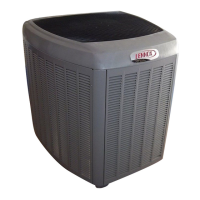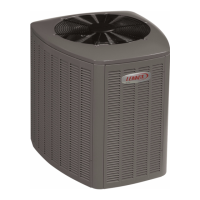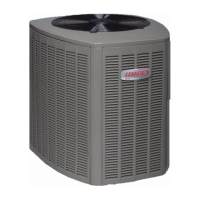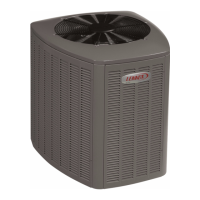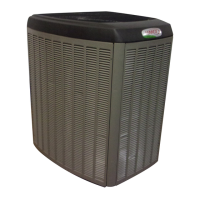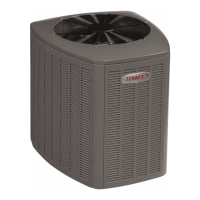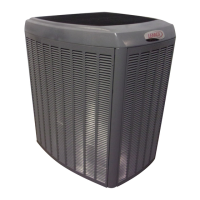Page 24
505367M 04/08
IMPORTANT
Sprinklers and soaker hoses should not be installed
where they could cause prolonged exposure to the
outdoor unit by treated water. Prolonged exposure
of the unit to treated water (i.e., sprinkler systems,
soakers, waste water, etc.) will corrode the surface
of steel and aluminum parts and diminish
performance and longevity of the unit.
6. Outdoor UnitMake sure no obstructions restrict
airflow to the outdoor unit. Leaves, trash or shrubs
crowding the unit cause the outdoor unit to work harder
and use more energy. Keep shrubbery trimmed away
from the unit and periodically check for debris which
collects around the unit. When removing debris from
around the unit, be aware of metal edges on parts and
screws. Although special care has been taken to keep
exposed edges to a minimum, physical contact with
metal edges and corners while applying excessive
force or rapid motion can result in personal injury.
Cleaning of the outdoor unit’s coil should be performed
by a trained service technician. Contact your dealer
and set up a schedule (preferably twice a year, but at
least once a year) to inspect and service your air
conditioning or heat pump system.
THERMOSTAT OPERATION
Thermostat operations vary from one thermostat to
another. The following provides general operation
procedures. Refer to the user’s information manual
provided with your thermostat for specific operation
details.
Temperature Setting Levers − Set the lever or dial to
the desired temperature setpoints for both heating and
cooling. Avoid frequent temperature adjustment;
turning the unit offthen back onbefore pressures
can equalize will put unusual stress on the unit’s
compressor.
Fan Switch − In AUTO or INT (intermittent) mode, the
blower operates only when the thermostat calls for
heating or cooling. This mode is generally preferred
when humidity control is a priority. The ON or CONT
mode provides continuous indoor blower operation,
regardless of whether the compressor or furnace is
operating. This mode is required when constant air
circulation or filtering is desired.
System Switch − Set the system switch for heating,
cooling or auto operation. The auto mode allows the
system to automatically switch from heating mode to
cooling mode to maintain predetermined comfort
settings.
Temperature Indicator − The temperature indicator
displays the actual room temperature.
PROGRAMMABLE THERMOSTATS
Your Lennox system may be controlled by a
programmable thermostat. These thermostats provide the
added feature of programmable time-of-day set points for
both heating and cooling. Refer to the user’s information
manual provided with your thermostat for operation
details.
Preservice Check
If your system fails to operate, check the following before
calling for service:
Make sure all electrical disconnect switches are ON.
Make sure the room thermostat Temperature Selector
and System Switch (Heat, Cool, Auto) are properly
set.
Check for and replace any blown fuses, or reset any
tripped circuit breakers.
Make sure unit access panels are in place.
Make sure air filter is clean.
Write down the unit model number and have it handy
before calling.
Optional Accessories
Refer to the Lennox XC14 Engineering Handbook for the
latest available accessories for this unit.
Start−Up and Performance Checklist
Job Name Job no. Date
Job Location City State
Installer City State
Unit Model No. Serial No. Service Technician
Nameplate Voltage
Rated Load Ampacity Compressor Outdoor Fan
Maximum Fuse or Circuit Breaker
Electrical Connections Tight? Indoor Filter clean? Supply Voltage (Unit Off)
Indoor Blower RPM S.P. Drop Over Indoor (Dry) Outdoor Coil Entering Air Temp.
Discharge Pressure Suction Pressure Refrigerant Charge Checked?
Refrigerant Lines: Leak Checked? Properly Insulated? Outdoor Fan Checked?
Service Valves: Fully Opened? Caps Tight? Thermostat
Voltage With Compressor Operating Calibrated? Properly Set? Level?
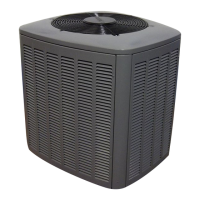
